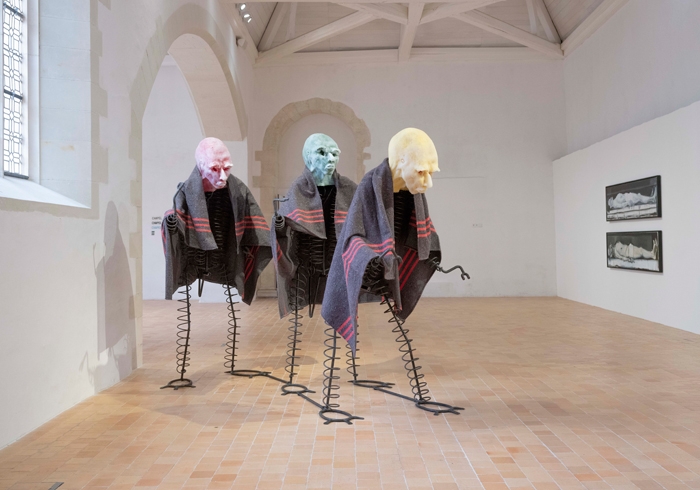Political in its origins as well as in its messaging, the Pinault Collection’s staging of Debout! (Stand Up!) across two venues in Rennes this summer brings together work by artists who will be familiar to visitors to the collection’s Venice museums – Palazzo Grassi and Punta della Dogana – and other global artworld venues but who will not have been widely shown in the capital of Brittany. In fact, according to its organisers, many of the works on view here have not been seen anywhere since they were acquired by the collection, and one suite of works, by Vincent Gicquel, comes straight from the artist’s studio, so their presentation in Rennes has symbolic heft. That the industrialist and supercollector François Pinault is native to this region, and that he will be opening a museum for his collection in Paris next year (at the historic Bourse de Commerce, under terms similar to those for his Venice spaces), has to have been part of the calculation: a prelude to a major homecoming.
Presented in the restored Couvent des Jacobins, a sixteenth-century convent more recently occupied by the French army and now a mixture of ancient stone and exterior and interior glass walls arranged to host conferences, Debout! is organised into five ‘sequences’, commencing in an atrium that connects the old and new structures, and weaving through spaces that were not designed for the display of art. More than half of the 21 artists in Debout! are represented by multiple works, some placed at different points across the exhibition, others grouped together.
To say that the majority of these works haven’t been displayed before in public certainly doesn’t mean the exhibition is stocked with obscure art. Thomas Houseago’s monumental sculptures Baby (2009–10) and Striding Figure II (Ghost) (2012) lurk and loom in the atrium, alongside Thomas Schütte’s oxidised bronze sculpture Vater Staat (2010), before the visitor turns a corner to face Adel Abdessemed’s Cri (2013), the lifesize ivory incarnation of Phan Thi Kim Phuc, famously photographed as she fled a napalm attack in Vietnam in 1972. From one icon to another: Jake & Dinos Chapman’s Fucking Hell (2008) occupies all but an edge of the next partitioned space, where Duane Hanson’s Baby in Stroller (1995), just visible through a gap in the vitrines of Nazi mayhem (the gap itself forming a swastika), maximizes incongruity. Maurizio Cattelan’s kneeling Hitler (Him, 2001) faces the wall in a space that also contains a flayed, faceless corpse by Berlinde de Bruyckere (Romeu, 2010).
The mood shifts from open warfare to subtler acts of aggression as one reenters the atrium and crosses into the historical structure of the convent, where painted portraits by Henry Taylor and Lynette Yiadom-Boakye share space with two more Houseago sculptures. Pierre Huyghe’s film Untitled (Human Mask) (2014), in which a monkey wearing a face mask and dressed as a little girl moves agitatedly through a hastily abandoned restaurant, makes connections between man and beast, as well as between humanity’s exploitation of nature and a possible posthuman future.
Implicit in the imperative of the title is that now is indeed the time to stand up – for one’s principles; for the weak; for oneself, to pick oneself off the floor, to stand on two legs. But as if to offer a counterpoint to the portentousness of Debout!, along comes Vincent Gicquel’s C’est Pas Grave (It’s No Big Deal), staged simultaneously in Rennes, but not as part of the Pinault tour-de-force. On view at La Criée Centre for Contemporary Art, the work expands on the suite of his paintings shown in Debout!, where existentially perplexed nude figures gaze out at the viewer, looking caught in the act of something momentous, possibly pleasurable, possibly damning, though neither we nor those figures are sure what that act was. Tatiana Trouvé has installed a number of untitled works from her Les Dessouvenus series (works from 2013 and 2017 included here) in an interior patio of the Musée des Beaux-Arts, the exhibition’s second location. Arranged on an armature that fills this space, Trouvé’s works (the title translates as ‘the disremembered’) are drawings on canvas whose underlying pigment has been partially removed through the application of bleach; in sharp contrast to many of the works at the Couvent des Jacobins, these focus on absence, silence and the sketchiness of memory.
Debout! is responding to an interesting combination of demands: to participate in civic and regional boosterism while also previewing parts of the Pinault Collection to a hometown public; to select works that will stimulate without alienating, that will educate, challenge and entertain in the right measures; to occupy a new space, one never intended for exhibiting art, and on short notice. As for whether life is getting better or worse, a question one might well ask oneself while touring this exhibition, there are guides for everyone, pointing us to look at how we treat each other, particularly the less powerful and the vulnerable; at how we treat the environment; at humanity’s cycles of extreme violence; at belief and disillusionment; at our stubborn perseverance.
Collection Pinault: Debout! is on view at the Couvent des Jacobins and Musée des Beaux-Arts, Rennes, through 9 September
Online exclusive, published on 20 July 2018
